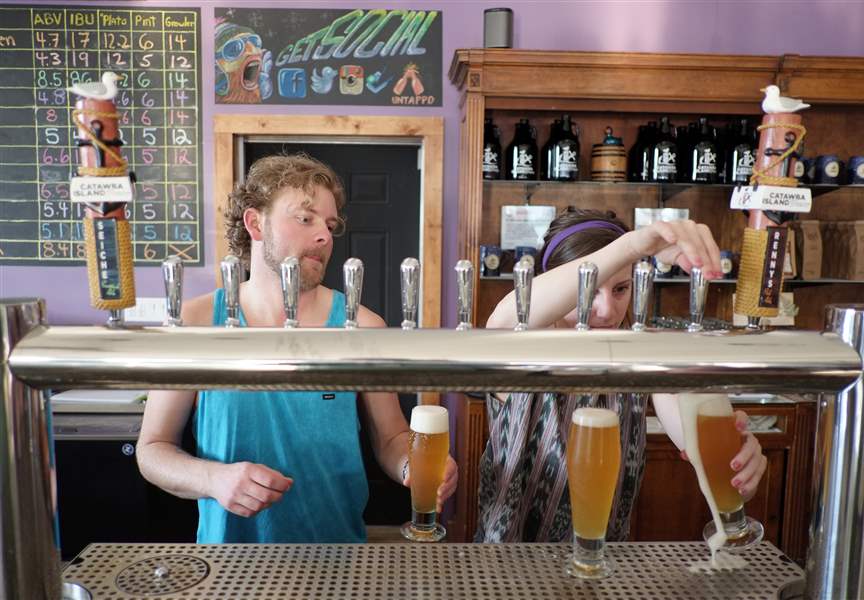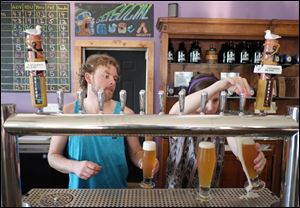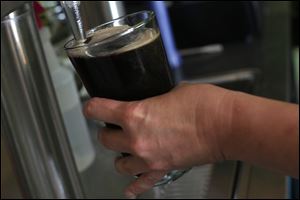
A taste for success: Taprooms have been a real boon for area craft brewers
6/8/2014
Bar manager Lenny Kromer and bartender Taylor Fletcher fill glasses with beer at the Catawba Island Brewing Co.'s Tasting Room in Port Clinton, Ohio.
THE BLADE/JEREMY WADSWORTH
Buy This Image

Bar manager Lenny Kromer and bartender Taylor Fletcher fill glasses with beer at the Catawba Island Brewing Co.'s Tasting Room in Port Clinton, Ohio.
Some call them tasting rooms. Others call them taprooms. No matter the name, they’re what keep the doors open at area craft breweries.
Tasting rooms are not a new option for small Ohio breweries, but it was a change in the state liquor law that came into effect in 2013 that has spurred growth in the niche beer industry at the local level.
It used to be that breweries had to fork over $3,906 annually for a liquor license and an additional $3,906 to operate a tasting room. But last year the fee for the tasting room was reduced to $1,000 to help craft brewers grow.
No matter the name, they’re what keep the doors open at area craft breweries.
Open 4-10 p.m. Wednesday through Saturday; 1-6 p.m. Sunday.
Address: 2330 E. Harbor Rd., Port Clinton
Phone: 419-960-7764
Website: catawbaislandbrewing.com
● Findlay Brewing Co.
Open 5 to 10 p.m. Friday.
Address: 227 ½ N. Main St., Findlay
Phone: 419-722-7395
Website: findlaybrewingcompany.com
● Flatrock Brewing Co.
Open 4-10 p.m. Thursday and Friday; 3-10 p.m. Saturday.
Address: 215 Railway Ave., Holgate
Phone: 419-966-1440
Website: flatrockbrewery.com
● Sugar Ridge Brewery
Open 5-10 p.m. Thursday; 5-11 p.m. Friday and Saturday.
Address: 17745 N. Dixie Hwy., Bowling Green
Phone: 419-373-6553
Website: sugarridgebrewery.net
Tasting rooms are not a new option for small Ohio breweries but now they are more affordable. It was a change in the state liquor law that came into effect in 2013 that has spurred growth in the niche beer industry at the local level.
It used to be that breweries had to fork over $3,906 annually for a liquor license and an additional $3,906 to operate a tasting room. But last year the fee for the tasting room was reduced to $1,000 to help craft brewers grow.
Craft breweries opening in Bowling Green, Findlay, Port Clinton, and even tiny Holgate is all the proof needed that the price reduction has been a success.
“When we first opened, we had to pay the four grand for the A1C [liquor license] and then we were contacted when we were going to renew for 2013 that it went down to $1,000,” said Lawrence Pritchard III, head brewer at Flatrock Brewing Co. in Holgate. “So that helped out a lot because our profit margins are razor thin, because we don’t make a lot of beer. We could use that extra money to expand our brewing operations.”
Steve Treece, one of six founding partners at Findlay Brewing Co., agreed.
“In fact, that’s what’s kind of helped us stay in business is that lower fee,” Treece said. “It’s just about $4,000 and we paid that our first year of existence and we were pretty happy that we didn’t have to pay that again a year later.”
Another reason the tasting room has become so popular is the short distance between keg and customer. Not only does that result in a freshness that’s hard to duplicate at proper pubs and restaurants, but instantaneous feedback is a brewer’s best friend.
Mike Mullins, owner of Sugar Ridge Brewery in Bowling Green, brews his beer — 22 different kinds, with eight on tap at a time —in the back of his building and then can see what the customers like in the taproom.
“We sit and talk about it across the bar,” said Mullins, who started home-brewing in 1993.
It’s a creative process that’s benefited both the brewer and the beer drinker.
“The main advantage is, we can really get some of our experimental ales and some of the recipes we’re working on out to customers in our shop, so we kind of educate the people coming in what the ingredients are and the beer style,” Pritchard said. “We kind of try out different flavors and get an instant reaction, versus getting a reaction from a bar or restaurant that we might distribute to.”
That also can cause inadvertent competition with an unwanted side effect of having a popular tasting room.
“No. 1, we’re in the business of making beer,” said Cindy Gunderson, a partner at Catawba Island Brewing Co. in Port Clinton. “The tasting room, conceptually, could quickly go to the status of a bar or a brewpub, and that’s not really where we wanted to focus it. We didn’t want to create this product and then compete with the people who [are selling] the product. That was one of the reasons for limiting our days and hours.”

Bartender Sherri Daver pours a Sylvania Stout for a customer at Sugar Ridge Brewery in Bowling Green.
Taprooms usually are open just a few days a week, often because very small breweries, better known as nanobreweries, make just enough beer to meet the demand.
Also, according to state law, the taprooms can only sell beer made at the breweries. While growlers also can be filled at the tasting rooms, they cannot be consumed there. Samples of the product also can be served.
The taprooms vary in size and sophistication, and that’s left up to the discretion of the breweries.
“Tasting rooms can be as rustic as setting up a table at the microbrewery or they have the flexibility to get a little more industrial,” said Mary MacDonald, executive director of the Ohio Craft Brewers Assoc.
Findlay’s taproom is less than 400 square feet and is open just one night a week: Friday. The brewery’s burgeoning popularity is mostly to blame, but the six owners also have full-time jobs.
“We see a lot of regulars every Friday,” Treece said “We’re pretty sure there’s a pretty good contingent of people in Findlay that aren’t aware we’re in existence or where we’re at even, but we’re almost afraid to advertise because we’re already packed some nights out the door and we’re selling everything we’ve got.
“There’s still a big market out here waiting to be tapped. We’re sure of that.”
The demand for fresh, craft beer is a national trend, and the adjustment to Ohio’s liquor law was made, in part, to help catch up to states like Michigan, which boasts more than 100 craft breweries in the country.
Area brewers like Pritchard and Mullins have witnessed the growing popularity with their own eyes.
Pritchard said Flatrock completely ran out of beer at its tasting room on a recent Saturday.
Mullins points to steady growth at Sugar Ridge, which opened the week before Christmas.
“Each month has been busier than the previous month,” he said. “It’s been slow growth, so that’s good.”
Opportunity for expansion is the next logical step for the northwest Ohio brewers.
Catawba Island will start distributing some of its beers in cans later this month. It also has gained a food operator’s license and started selling pizza from a local pizzeria.
Flatrock, which Pritchard said is determined to remain in Henry County, is looking at locations for a larger facility in Napoleon or considering building a new brewery in Holgate.
Findlay Brewing, located on the northern end of downtown, is pondering a move a more centralized location to take advantage of increased foot traffic.
Sugar Ridge, which has a rather large facility at 2,500 square feet, has room to expand on site.
“I was fortunate to get some good highway frontage on [State Route 25],” said Mullins, who lives in Perrysburg. “ I live about 15 minutes from the brewery. It’s close and a good market. We could expand here if needed.”
Like other do-it-yourself businesses, craft brewers don’t have an advertising budget and use forms of social media to help spread news about their beer. But nothing can replace old-fashioned word of mouth and the taproom helps cement the breweries’ reputation.
“Especially in this part of Ohio, word of mouth is a really big thing because people have relatives in different communities in northwest Ohio,” Pritchard said. “They’ll go back and tell an aunt or uncle or brother or whoever, ‘You guys have to make it to Holgate for this beer.’”
But maybe, at the end of the day, it’s just about having a place to unwind with a quality brew you can’t get anywhere else.
“Our tasting room is very laid back, low-key,” Gunderson said. “It doesn’t matter if you’re 25, you’re going to relax and enjoy yourself, or if even you’re 65. I love the diversity.”